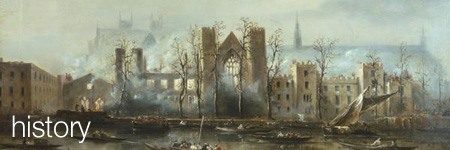
Borough High Street
Southwark (SE1) Near the end of this road stood the Queen's Bench Prison, a place of great antiquity, where Henry, Prince of Wales, the future victor of Agincourt, was committed by the Lord Chief Justice, Sir William Gascoyne, for insulting, if not striking him, on the Bench. (Reference: Jesse's London, vol. III, p. 423) Only the "King's Head "and the "George" now remain of the many famous old hostelries in the Borough High Street. There is a modern tavern styled the "Blue-eyed Maid." Like the "White Hart," the original " Blue-eyed Maid" figures in the pages of Dickens. Mr. Arthur Clennam passed a dismal Sunday evening after his journey from Marseilles to Dover and thence by "The 'Blue Ey'd Maid ' Coach " (Little Dorrit) . The famous old Tabard is now a tavern restaurant. From the old inn Canterbury Pilgrims departed on their journey two hundred years or so before Chaucer wrote. In 1676 a fire swept away the "Tabard," the "George," the " King's Head," the "Queen's Head," the "White Hart," and other ancient inns in this street. They were all rebuilt, but through ignorance of the meaning of the sign of the Tabard-the sleeveless coat worn by the heralds-the name of Chaucer's inn was changed to the Talbot. This is the origin of the Talbot yard adjoining. It was in the vestry of the Church of St. George the Martyr that "Little Dorrit" is supposed to have slept on the night of her party, and was married here later. The "White Hart," of Pickwickian memory, also no longer exists. The "George " is to-day the sole survivor of the old galleried inns.